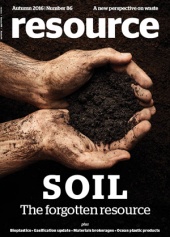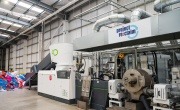Compound questions: what happens to composite plastics after use?
Composite materials like fibreglass are strong, durable and light, making them ideal for any number of applications. The only trouble is, they’re not very easy to handle at their end of life. Will Simpson learns more
It is one of the most commonly-used materials, but one that remains deeply problematic when it reaches the end of its life. Fibreglass is hard, durable and light and can be produced in any number of complex shapes: its applications range from boat hulls to wind turbines, from surfboards to bike helmets. But as it stands, the majority of it still ends up in landfill.

The issues it throws up in terms of recycling have been a frustration to the fibreglass industry for some time, though, as the compound material – that sees glass fibres reinforced with plastic – is particularly tricky to handle at end of life. “It’s difficult to recycle because it is difficult to go back to the original components”, explains Roberto Frassine, researcher and ex-Chairman of the European Composites Industry Association (EuCIA).
“Usually, the product’s shape cannot be modified in any way, because you cannot melt the resin. The only way to reshape fibreglass is to recover the original components – the resin and the fibre – and impregnate the fibre with a liquid resin and start the process all over again. It’s not like a metal that you can melt and reshape it. You cannot reshape a fibreglass product.”
There are two main ways fibreglass can be recycled at present. One is to treat the material with high pressure and heat it to a high temperature, thereby destroying the chemical structure of the fibreglass resin and recovering some of the original constituents. The problem with this process is that it’s expensive and requires a specialist chemical treatment plant.
The other, which many would hesitate (or refuse) to label ‘recycling’, is to decompose the material at high temperature and capture some of the energy content of the resin, as EuCIA outlined in a brochure it produced in 2013 called ‘Composites Recycling Made Easy’. “This is similar to if you were burning coal or oil”, says Frassine. “In Europe, one of the major processes to recycle composites is the so called ‘cement kiln’ route, where you use composites as a raw material to produce cement.”
But, as Frassine himself admits, this is not ideal. “You are downgrading the material. You also have to pay a fee to the cement kiln owners to dispose of the fibreglass, so this is not very profitable. But at least this is economically viable – the cement kiln owners say that it is a good raw material for producing cement.” Nevertheless, there are some projects that have tried to find a solution to the fibreglass problem. In Denmark, a project called Dreamwind (Designing REcyclable Advanced Materials for WIND energy) aims to produce a new (and, crucially, entirely recyclable) kind of composite material for wind turbine blades, using a combination of virgin and non-virgin fibreglass. The idea is to eventually produce a blade that can easily be disassembled at the end of its natural life – unlike blades in use today.

Dreamwind is backed by the University of Aarhus and Danish Technological Institute, but is still in its early stages. “We have not yet progressed to the stage of making prototypes or scalable products”, admits Allan Hjarbaek Holm, Dreamwind Specialist Materials Senior.
“The work we’ve done so far is in the lab, seeing if we can demonstrate if these things could work. We are also discussing what the business model would look like. If we do this and you suddenly have some sort of value on a scrap turbine, how would we then process this and how would the market change in response? What are the implications of it changing from something that costs to get rid of to something that can be turned into a value of some sort?”
Dreamwind hasn’t yet cracked the conundrum of how to separate the components of this new fibreglass, but is looking at completing a prototype that does so by 2020. Holm is confident that, if successful, Dreamwind’s process could be applied to other industries that use fibreglass products. “But”, he cautions, “there are a lot of technical assessments that have to be done to answer whether it’s acceptable in a future blade design. We will have something that is not a virgin material and may be a little bit inferior to what you get if you buy virgin material. We have to address that before we can really look into what it means from a business perspective.”
Meanwhile, in Italy, another project has been quietly exploring the possibilities of fibreglass recycling since the turn of the century and has a line of recycled composite material, Glebanite, certified by the Construction Specifications Institute. The company, Rivierasca, is the brainchild of engineer Giacomo Bonaiti, who explains one way fibreglass can be recycled – by recasting ground-up fibreglass powder into a mould. “We are using very simple technology”, explains Bonaiti. “Once you have the ground-up powder you can add fresh resins to the mixture and create a liquid mixture, which you can cast into any shape you may have finished. We have already produced fibreglass statues using this process.” Bonaiti adds that the material can be used in furniture production or for facades, for instance, and, as a next step, he plans to create a mobile recycling machine that can be moved to where fibreglass scraps are likely to be found. The idea is to take it to a couple of companies in Italy that have expressed an interest in recycling material from boats, something he wants to develop “sometime in 2017”.
Over in Washington state in the US, there is also Global Fiberglass Solutions, a project whose original idea was to produce a recycled fibreglass railway sleeper. “The technique we used was to shred and grind the material down to a specific length,” explains Company President Don Lilly. “Before using an open mould system. Once the sleeper was actually produced, it would take no more than 90 minutes to set. Three to four hours later, it would be ready to go on a track.”
 This article was taken from Issue 86
This article was taken from Issue 86The problem, as with much fibreglass recycling, was finding the right source material. After trying disused aircraft and boat hulls, Lilly alighted on wind turbine blades as the most cost-efficient and easily-available source. Since its original railway sleeper prototype, Global Fiberglass Solutions has also produced prototypes of a recycled fibreglass manhole cover and ‘moisture proof, fire-resistant’ construction panel. Lilly claims that the company will be able to start mass producing these items in 2017: “We’re on the verge of making it competitive. The process has to be something that people can see that they will receive a return on their investment, but we now have major architectural firms as well as builders that are now looking to utilise the materials we’re looking to produce.”
However, despite Lilly’s optimism, fibreglass recycling remains some way from the mainstream. Frassine suggests that for any serious progress to be made in this area, regulations would need to be put in place: “It’s not like something that is spontaneously going to occur in the industry, which is always tending to maximise profit. But if the change of public opinion, some regulations at a European level or probably a combination of both were to happen, that could force companies to develop recycling strategies. But it’s not a process that is likely be self-developed by industry.”
Certainly, for all the exciting developments in labs and R&D departments around the globe, it looks like landfill will continue to be the final destination for fibreglass for some time to come. 




